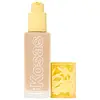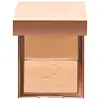Kosas Revealer Skin-Improving Foundation SPF 25 Versus Patrick Ta Major Skin Crème Foundation and Finishing Powder Duo
What's inside
What's inside
 Key Ingredients
Key Ingredients

 Benefits
Benefits

 Concerns
Concerns

 Ingredients Side-by-side
Ingredients Side-by-side

Zinc Oxide 7.5%
Cosmetic ColorantWater
Skin ConditioningEthylhexyl Olivate
Skin ConditioningOctyldodecanol
EmollientUndecane
EmollientPolyglyceryl-2 Dipolyhydroxystearate
Skin ConditioningGlycerin
HumectantMica
Cosmetic ColorantCalcium Sodium Borosilicate
Caprylic/Capric Triglyceride
MaskingNiacinamide
SmoothingPolyglyceryl-3 Diisostearate
EmulsifyingGalactoarabinan
Tridecane
PerfumingPropanediol
SolventCetyl Alcohol
EmollientGlyceryl Oleate
EmollientSodium Hyaluronate
HumectantPalmitoyl Tripeptide-5
Skin ConditioningPanthenol
Skin ConditioningSqualane
EmollientCaffeine
Skin ConditioningArnica Montana Flower Extract
MaskingArtemisia Capillaris Flower Extract
Skin ConditioningEthyl Ferulate
AntioxidantSodium Gluconate
Skin ConditioningPolyhydroxystearic Acid
EmulsifyingMaltodextrin
AbsorbentPentylene Glycol
Skin ConditioningLecithin
EmollientHydrogenated Lecithin
EmulsifyingTocopherol
AntioxidantPhenethyl Alcohol
MaskingCI 77891
Cosmetic ColorantIron Oxides
Zinc Oxide 7.5%, Water, Ethylhexyl Olivate, Octyldodecanol, Undecane, Polyglyceryl-2 Dipolyhydroxystearate, Glycerin, Mica, Calcium Sodium Borosilicate, Caprylic/Capric Triglyceride, Niacinamide, Polyglyceryl-3 Diisostearate, Galactoarabinan, Tridecane, Propanediol, Cetyl Alcohol, Glyceryl Oleate, Sodium Hyaluronate, Palmitoyl Tripeptide-5, Panthenol, Squalane, Caffeine, Arnica Montana Flower Extract, Artemisia Capillaris Flower Extract, Ethyl Ferulate, Sodium Gluconate, Polyhydroxystearic Acid, Maltodextrin, Pentylene Glycol, Lecithin, Hydrogenated Lecithin, Tocopherol, Phenethyl Alcohol, CI 77891, Iron Oxides
Lac Powder
Skin ConditioningSilica
AbrasiveMica
Cosmetic ColorantLauroyl Lysine
Skin ConditioningZinc Stearate
Cosmetic ColorantNylon-12
Kaolin
AbrasiveOctyldodecyl Stearoyl Stearate
EmollientDimethicone
EmollientPolymethylsilsesquioxane
Polysilicone-11
Isononyl Isononanoate
EmollientMagnesium Myristate
Magnesium Ascorbyl Phosphate
AntioxidantAnthemis Nobilis Flower Water
MaskingTocopheryl Acetate
AntioxidantSodium Benzoate
MaskingPotassium Sorbate
PreservativeCaprylyl Glycol
EmollientPhenoxyethanol
PreservativeCitric Acid
BufferingHexylene Glycol
EmulsifyingLaureth-12
EmulsifyingTriethoxycaprylylsilane
CI 77891
Cosmetic ColorantCI 77491
Cosmetic ColorantPPG-3 Benzyl Ether Myristate
EmollientEthylhexyl Isononanoate
EmollientDivinyldimethicone/Dimethicone/Phenylsilsesquioxane Crosspolymer
Polyethylene
AbrasivePentaerythrityl Tetraisostearate
EmollientBis-Stearyl Dimethicone
EmollientButyl Acrylate/Hydroxypropyl Dimethicone Acrylate Copolymer
Ethylhexyl Palmitate
EmollientIsopropyl Myristate
EmollientLecithin
EmollientPolyhydroxystearic Acid
EmulsifyingPolyglyceryl-10 Polyricinoleate
EmulsifyingPentaerythrityl Tetra-Di-T-Butyl Hydroxyhydrocinnamate
AntioxidantIsostearic Acid
CleansingLac Powder, Silica, Mica, Lauroyl Lysine, Zinc Stearate, Nylon-12, Kaolin, Octyldodecyl Stearoyl Stearate, Dimethicone, Polymethylsilsesquioxane, Polysilicone-11, Isononyl Isononanoate, Magnesium Myristate, Magnesium Ascorbyl Phosphate, Anthemis Nobilis Flower Water, Tocopheryl Acetate, Sodium Benzoate, Potassium Sorbate, Caprylyl Glycol, Phenoxyethanol, Citric Acid, Hexylene Glycol, Laureth-12, Triethoxycaprylylsilane, CI 77891, CI 77491, PPG-3 Benzyl Ether Myristate, Ethylhexyl Isononanoate, Divinyldimethicone/Dimethicone/Phenylsilsesquioxane Crosspolymer, Polyethylene, Pentaerythrityl Tetraisostearate, Bis-Stearyl Dimethicone, Butyl Acrylate/Hydroxypropyl Dimethicone Acrylate Copolymer, Ethylhexyl Palmitate, Isopropyl Myristate, Lecithin, Polyhydroxystearic Acid, Polyglyceryl-10 Polyricinoleate, Pentaerythrityl Tetra-Di-T-Butyl Hydroxyhydrocinnamate, Isostearic Acid
Ingredients Explained
These ingredients are found in both products.
Ingredients higher up in an ingredient list are typically present in a larger amount.
Ci 77891 is a white pigment from Titanium dioxide. It is naturally found in minerals such as rutile and ilmenite.
It's main function is to add a white color to cosmetics. It can also be mixed with other colors to create different shades.
Ci 77891 is commonly found in sunscreens due to its ability to block UV rays.
Learn more about CI 77891Lecithin is a term for a group of substances found in the cell membranes of plants, animals, and humans. They are made up of mixture of phospholipids.
This ingredient has emollient and emulsifying properties.
As an emollient, lecithen helps soften the skin and creates a barrier to keep moisture in.
As an emulsifier, it also helps prevent water and oil ingredients from separating. Lecithin can also help ingredients be better absorbed by the skin.
This is because the phospholipids in lecithin produce liposomes. Liposomes help other ingredients get through the skin barrier.
Depending on the source of this ingredient, lecithin may not be fungal acne safe. This is because some sources of lecithin come from soybean oil, which may feed the malassezia yeast that feeds fungal acne.
We recommend reaching out to the brand you are purchasing from to inquire about the source of their lecithin.
Some other names for this ingredient include soy lecithin and deoiled soy lecithin.
Learn more about LecithinMica is a naturally occurring mineral used to add shimmer and color in cosmetics. It can also help improve the texture of a product or give it an opaque, white/silver color.
Serecite is the name for very fine but ragged grains of mica.
This ingredient is often coated with metal oxides like titanium dioxide. Trace amounts of heavy metals may be found in mica, but these metals are not harmful in our personal products.
Mica has been used since prehistoric times throughout the world. Ancient Egyptian, Indian, Greek, Roman, Aztec, and Chinese civilizations have used mica.
Learn more about MicaPolyhydroxystearic Acid is a soft wax made from castor oil.
It is is a texture thickener, emulsifier, and film-former. Emulsifiers prevent ingredients from separating, such as oils and waters.
Polyhydroxystearic Acid may not be fungal acne safe.
Learn more about Polyhydroxystearic Acid